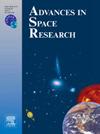Analysis of long-term and short-term bankline stability prediction considering seasonal variations: A study in lower Ganga Basin, India
IF 2.8
3区 地球科学
Q2 ASTRONOMY & ASTROPHYSICS
引用次数: 0
Abstract
River bank instability in the lower Ganga plain has been a major concern since the early 1850s due to its huge catchment flux and transboundary character, especially in the districts of Malda and Murshidabad. This study examines the seasonal dynamics of banklines in the upper and lower Farakka regions. The study assesses seasonal changes in the lower Ganga regions over 68 years (1955–2022) and projects trends for the next 22 years (2022–2044) using a GIS-based Digital Shoreline Analysis System (DSAS) approach. Long-term erosion prevails on the left bank at −19.38 ± 2.83 m yr^-1 (LRR method), with 38.61 % of transects showing a significant (p < 0.05) erosional rate, covering 58.85 % of total erosional transects. The right bank experiences accretion at a rate of 6.82 ± 2.83 m yr^-1, with 27.66 % of transects showing a significant erosional rate, covering 46.10 % of total erosional transects. Short-term fluctuations show erosion-accretion values surpassing the 50 % threshold, highlighting dominant erosion in 1975–1980 and 1985–2015. The non-cyclic erosion-accretion nature unveils erosional processes in 1975–2000 and 2010–2015 and accretional processes in 2000–2010 and 2015–2021 on the right bank during the monsoon season. The dynamics of the projected bank lines exhibit an accretional tendency over the right bank and an erosional trend over the left. Moreover, a strong correlation between the actual and expected bank lines is shown by the value surpassing 0.95 for all seasons on both the left and right banks. The erosional trends are evident in Chachunda at a rate of −152.45 ± 198.92 m yr^-1, while Loharpur and Shikdarpur exhibit erosional rates of −237.88 ± 211.30 m yr^-1 and −243.59 ± 207.91 m yr^-1, respectively, in the lower Farakka. The seasonal long-term and short-term analyses are influenced by various forcing mechanisms like high sediment flux, enormous discharge, and drastic anthropogenic intervention that drives changing foci of erosion and accretion.
考虑季节变化的长期和短期岸线稳定性预测分析:印度甘加河流域下游研究
本文章由计算机程序翻译,如有差异,请以英文原文为准。
求助全文
约1分钟内获得全文
求助全文
来源期刊

Advances in Space Research
地学天文-地球科学综合
CiteScore
5.20
自引率
11.50%
发文量
800
审稿时长
5.8 months
期刊介绍:
The COSPAR publication Advances in Space Research (ASR) is an open journal covering all areas of space research including: space studies of the Earth''s surface, meteorology, climate, the Earth-Moon system, planets and small bodies of the solar system, upper atmospheres, ionospheres and magnetospheres of the Earth and planets including reference atmospheres, space plasmas in the solar system, astrophysics from space, materials sciences in space, fundamental physics in space, space debris, space weather, Earth observations of space phenomena, etc.
NB: Please note that manuscripts related to life sciences as related to space are no more accepted for submission to Advances in Space Research. Such manuscripts should now be submitted to the new COSPAR Journal Life Sciences in Space Research (LSSR).
All submissions are reviewed by two scientists in the field. COSPAR is an interdisciplinary scientific organization concerned with the progress of space research on an international scale. Operating under the rules of ICSU, COSPAR ignores political considerations and considers all questions solely from the scientific viewpoint.
 求助内容:
求助内容: 应助结果提醒方式:
应助结果提醒方式:


